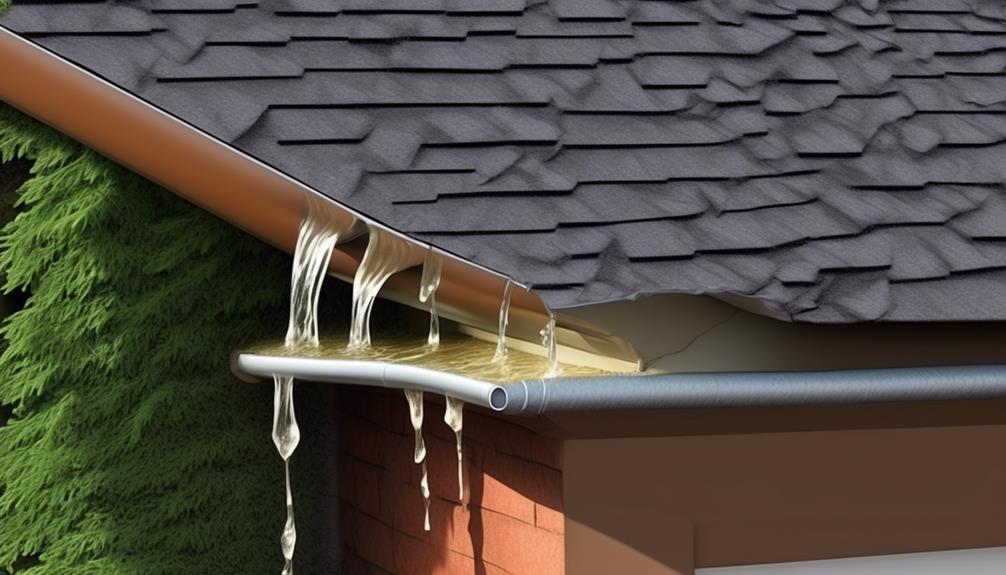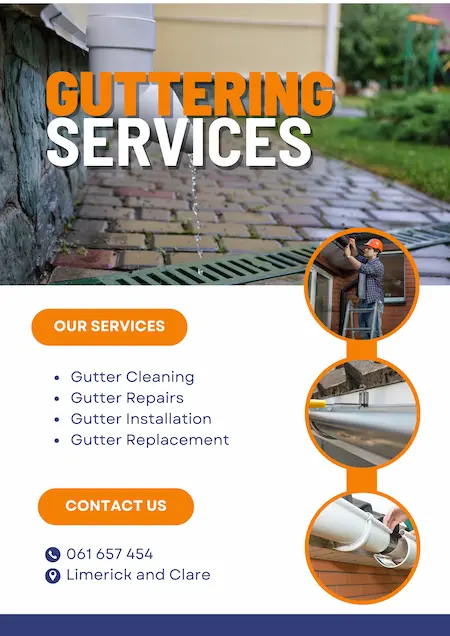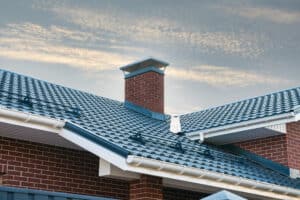Table of Contents
ToggleIs your property showing signs that gutter repair is needed? Damaged gutters can lead to serious structural problems including foundation damage, basement flooding, and fascia rot.
At Guttering Services, we’ve seen firsthand how neglected gutters cause thousands in preventable damage to Limerick and Clare properties. Water overflow from broken gutters erodes soil around foundations, damages landscaping, and creates perfect conditions for mould growth in walls and ceilings.
This comprehensive guide covers the warning signs of gutter damage, common repair solutions, and how our professional repairs save you money by preventing costly structural repairs.
We’ll also explain why DIY fixes often lead to bigger problems and how professional gutter repair provides lasting protection.
Contact Guttering Services today for a free gutter inspection and repair quote to protect your property from water damage year-round.
Key Takeaways
- Water pooling around the foundation can indicate faulty gutter installation or poor upkeep, causing potential damage to your home’s structure.
- To avoid water pooling, ensure proper gutter installation with correct angles and securely connected downspouts directing water away from the foundation.
- Regular gutter maintenance, including cleaning out debris and addressing any damage like leaks or sagging sections, is crucial to keep gutters in good condition.
- Cracks, holes, excessive rust, or corrosion on gutters can lead to water damage and structural issues, emphasizing the importance of routine maintenance and prompt repairs or replacement.
Water Pooling Around Foundation
Water pooling around your foundation indicates a serious issue that threatens your home’s structural integrity. This common problem often stems from improper gutter installation or inadequate maintenance.
Faulty gutters fail to direct water away from your home, allowing it to saturate the soil and exert pressure on foundation walls. Prevent this damage by ensuring proper gutter installation with appropriate angles for efficient water flow and correctly positioned downspouts.
Regular cleaning to remove debris blockages and prompt repair of leaks or sagging sections will maintain system effectiveness and protect your foundation from costly water damage.
Gutters clogged with leaves, twigs, and debris cannot properly channel rainwater away from your home during heavy storms. When water cannot flow through these obstructed pathways, it spills over gutter edges, potentially causing significant structural damage.
Regular gutter cleaning prevents these overflow issues by removing accumulated debris before it creates blockages. Installing gutter guards provides additional protection by filtering out leaves and other materials while allowing water to flow freely through your drainage system.
Proper gutter maintenance protects your home’s foundation, walls, and roof from water damage. Overflowing gutters lead to foundation pooling, wall seepage, and roof deterioration; all of which result in expensive repairs that could be avoided through simple preventive care.
Sagging or Detached Gutters
Sagging or detached gutters signal a serious issue requiring immediate attention to prevent extensive property damage. These visible symptoms indicate underlying problems that compromise your gutter system’s functionality.
Accumulated debris creates excessive weight that strains gutter attachments, causing them to pull away from your home. Regular cleaning prevents this buildup and maintains proper water flow through your drainage system. Professional maintenance ensures gutters remain securely fastened to your home.
Improper installation frequently leads to gutter failure under normal weather conditions. Gutters installed without adequate support brackets or at incorrect angles cannot withstand the weight of rainwater and debris. Professional installation services ensure your gutters have proper spacing between hangers and appropriate slope for effective drainage.
Visible Cracks or Holes in Gutters
Cracks and holes in your guttering system allow water to escape before reaching downspouts, creating serious risks to your property. This misdirected water accumulates around your foundation, causing soil erosion, basement flooding, and potential structural damage while promoting dangerous mold growth inside walls.
Regular gutter inspections help identify developing damage before it becomes severe. Minor cracks can be temporarily repaired with sealant or gutter tape, but these solutions only delay the inevitable need for proper repairs or replacement when damage is extensive.
Complete gutter replacement provides long-term protection by removing compromised sections and installing new, fully functional components. Professional installation ensures proper alignment, secure attachment, and appropriate water flow away from your home’s foundation to prevent costly structural damage.
Excessive Rust or Corrosion on Gutters

Rust and corrosion progressively destroy metal gutters, creating holes that allow water to escape and damage your property. This deterioration compromises the entire drainage system, leading to foundation issues, landscape erosion, and potential structural damage to your home.
Regular gutter maintenance prevents corrosion by removing debris that traps moisture against metal surfaces. Inspecting gutters seasonally allows you to identify early signs of rust before they develop into system failures that require complete replacement.
When rust appears, prompt action prevents further deterioration. Minor corrosion can be treated by removing rust, applying protective coatings, and replacing severely damaged sections. For extensive corrosion, complete replacement with rust-resistant materials like aluminum or vinyl provides long-term protection against future deterioration.
Frequently Asked Questions
You know, if you have water pooling around the base of your building, it’s a sign of looming trouble. This isn’t a small issue, it’s a big one that can hurt the very foundation of your building. What we’re talking about here isn’t just a few tiny cracks or a bit of shifting. No, we’re talking about possible major settling that can cause serious damage. And fixing it? Well, let’s just say it’s not going to be cheap. So, it’s best to address this issue promptly to avoid any significant damage to your property.
So, you’ve noticed your gutters are overflowing during those heavy rainstorms, huh? There are a couple of main culprits that might be causing this issue. Let’s chat about them, shall we?
First off, you’ve got your downspouts. Think of these as the highways for rainwater. Now imagine a highway jammed with cars – nothing moves, right? The same thing happens when downspouts are filled with leaves, twigs, and other gunk. The water simply can’t flow and ends up spilling over the sides of your gutters.
Then there’s the size of your gutters. Do you know how a small cup can’t hold a large amount of liquid? It’s the same concept. If your gutters are too petite, they won’t be able to keep up with a heavy downpour. So, like our cup, they’ll fill up and start to overflow.
In the end, it’s all about keeping those gutters clean and ensuring they’re the right size for your home. A quick check-up now can save you from a lot of water damage later. Stay dry, my friends!
If you’ve been slacking off on your gutter maintenance, brace yourself for a bit of a shocker. You see, sagging or detached gutters can lead to a host of problems for your property. And we’re not talking minor issues here. We’re talking about water damage that can affect your foundation, walls, and roof. Imagine coming home to find a leak in your roof or cracks in your walls, all because of neglected gutters – not a pretty picture, right?
So, what’s the solution? Regular gutter cleaning, my friend. It’s like a regular health check-up for your home. It helps nip potential problems in the bud, saving you from a world of hassle and expensive repairs. Trust me, your future self and your wallet will thank you for it.
You might be asking yourself, “Are visible cracks or holes in my gutters a big deal?” Well, they sure can be! These seemingly minor issues can actually cause significant water leakage, which in turn can result in some rather nasty property damage. So, how about we have a chat about the importance of giving your gutters a regular once-over to catch these problems early?
Now, if you do spot cracks or holes, don’t panic. You’ve got a couple of options for fixing them up. One method is to seal these pesky gaps, while another involves replacing the damaged sections entirely. Whatever route you choose, the key is to address these concerns promptly to prevent any further headaches down the line.
Let’s have a chat about the perils of letting rust or corrosion get the best of your gutters. It’s not something we usually think about, right? But ignoring it can lead to some serious issues like structural harm, water leaks, and even the complete breakdown of your gutter’s ability to do its job. That’s why it’s vital to keep on top of your gutter care. Regular upkeep is the key here – making sure they’re clean, sealing any little gaps that might pop up, and giving them a good coat of protective layer. Doing these simple things can save you a ton of stress down the line. So, let’s roll up our sleeves and show some love to our gutters, shall we? They deserve it!






